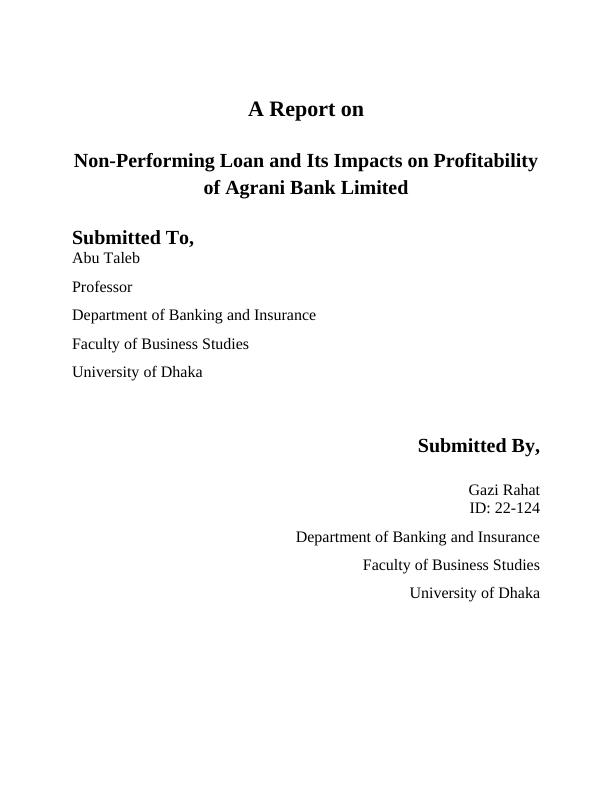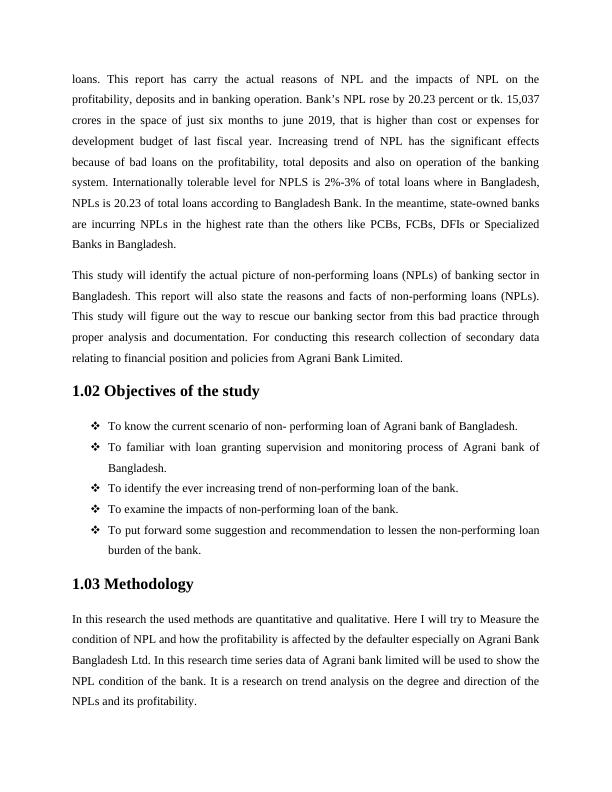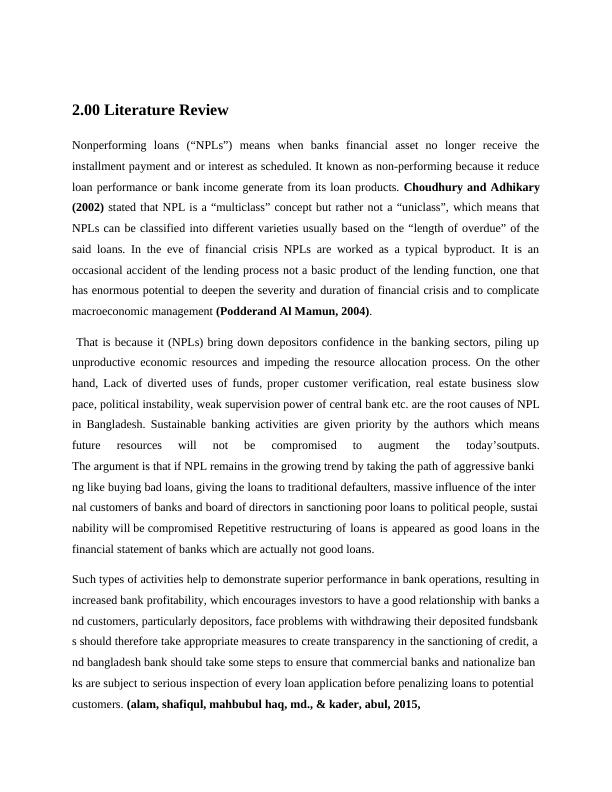Ask a question from expert
A Report on Non-Performing Loan and Its Impacts on Profitability
43 Pages8453 Words598 Views
Added on 2020-10-27
A Report on Non-Performing Loan and Its Impacts on Profitability
Added on 2020-10-27
BookmarkShareRelated Documents
A Report onNon-Performing Loan and Its Impacts on Profitabilityof Agrani Bank LimitedSubmitted To,Abu TalebProfessorDepartment of Banking and InsuranceFaculty of Business StudiesUniversity of DhakaSubmitted By,Gazi RahatID: 22-124Department of Banking and InsuranceFaculty of Business StudiesUniversity of Dhaka

Chapter-One: Introduction

1.00 IntroductionFor economic development, a country needs balanced and feasible flow of saving investmentprocess. Bangladesh now is in developing phase because of rapid growth in RMG sector but thisgrowth is also hampered by the underdeveloped capital market, raise of Non-performing loansboth on private commercial and state owned commercial banks. The intermediary activity of abank is providing loans to the potential investors by checking their credit worthiness.It is known that profitability of a bank is reduces by the NPL , because banks cannot generate theappropriate interest income from the classified loans. When a bank has high number of loandefaults than the bank has to set aside a portion of income as a loss reserve.At present, the Agrani Bank limited having unfavorable position of NPLs compare to otherprivate commercial banks in Bangladesh. “Bad Loan” management is the most unsatisfactoryperformance in the bank, which consistently accounts for more that 80% of total NPLs. Thisscenario is clearly saying that the inefficiency of the credit management to tackle the “flowproblem of bad loans”. Therefore, the first challenge facing Agrani Bank Limited is how toaddress the flow problem of bad loans.In Bangladesh there are nine state run banks and there are accounted for 51.27% of total NPL ofTK.1,16288.31 crore in banking sector. According to the ministry of finance Agrani bank has thepercentage of NPL in first quarter of 2019 is 16.67% and in second quarter it went down to14.5%.1.01 BackgroundNon-performing loans (NPL) or classified loans have a demolishing impact not only on overallbanking sector in Bangladesh but also on the whole economy of the country. Reasons behind theclassified loans are willful defaulters who are unwilling to repay the loans and next reason isloans go to down grade because of poor business performance due to changes in the politicaleconomy and environmental changes. For this NPL, provisions should be set aside on classified

loans. This report has carry the actual reasons of NPL and the impacts of NPL on theprofitability, deposits and in banking operation. Bank’s NPL rose by 20.23 percent or tk. 15,037crores in the space of just six months to june 2019, that is higher than cost or expenses fordevelopment budget of last fiscal year. Increasing trend of NPL has the significant effectsbecause of bad loans on the profitability, total deposits and also on operation of the bankingsystem. Internationally tolerable level for NPLS is 2%-3% of total loans where in Bangladesh,NPLs is 20.23 of total loans according to Bangladesh Bank. In the meantime, state-owned banksare incurring NPLs in the highest rate than the others like PCBs, FCBs, DFIs or SpecializedBanks in Bangladesh.This study will identify the actual picture of non-performing loans (NPLs) of banking sector inBangladesh. This report will also state the reasons and facts of non-performing loans (NPLs).This study will figure out the way to rescue our banking sector from this bad practice throughproper analysis and documentation. For conducting this research collection of secondary datarelating to financial position and policies from Agrani Bank Limited.1.02 Objectives of the studyTo know the current scenario of non- performing loan of Agrani bank of Bangladesh.To familiar with loan granting supervision and monitoring process of Agrani bank ofBangladesh.To identify the ever increasing trend of non-performing loan of the bank.To examine the impacts of non-performing loan of the bank.To put forward some suggestion and recommendation to lessen the non-performing loanburden of the bank.1.03 MethodologyIn this research the used methods are quantitative and qualitative. Here I will try to Measure thecondition of NPL and how the profitability is affected by the defaulter especially on Agrani BankBangladesh Ltd. In this research time series data of Agrani bank limited will be used to show theNPL condition of the bank. It is a research on trend analysis on the degree and direction of theNPLs and its profitability.

1.3.01 Research designA research design is considered as the framework or plan for a study that guides as well as helpsthe data collection and analysis of data. The research design may be exploratory descriptive andexperimental for the present study. The descriptive and experimental research design is adoptedfor this project. For this study purpose, I have conducted the time series data of Agrani BankBangladesh Ltd. to evaluate the impact of non-performing loans on profitability of the bank.1.3.02 Data CollectionThe data collection has been done from different journals and other reliable secondary sources tofind out the effect of NPLs on profitability and data from Agrani Bank Ltd.1.3.03 Data AnalysisThe data is collected from different authentic sources and analyzed to get the hints and factsabout the presumption that is whether there has impact of non-performing loan on profitability.There has been taken Secondary data to analyzed the regression and correlation among thedependent and independent variables. Dependent and independent variables have been taken toassess the association among them.1.04 Problem StatementThe mandatory aim of commercial bank is to generate profit by collecting the deposits from thecustomers of surplus units of money and lend loans to the people of deficit units of the financialsectors of a country. The purpose of our Banking sector is also the same. Non-performing loansare hampering the regular business activities of state owned commercial banks. Our state ownedcommercial banks follows rules and regulations from the Bank Company Act 1991 and time-to-time guidelines of Bangladesh bank. The most dangerous thing for our banking industry is theNPLs and it is increasing. The Bangladesh Bank is on the way to solve this problem. They areincreasing the provisions for classified loans to reduce aggressive lending. However, the amountof NPLs is not controlled by the commercial banks. My research proposal is to identify thecauses of non-performing loans, its actual amount, and find out the ways to get round the NPLs.

Chapter-Two: Literature Review

2.00 Literature ReviewNonperforming loans (“NPLs”) means when banks financial asset no longer receive theinstallment payment and or interest as scheduled. It known as non-performing because it reduceloan performance or bank income generate from its loan products. Choudhury and Adhikary(2002) stated that NPL is a “multiclass” concept but rather not a “uniclass”, which means thatNPLs can be classified into different varieties usually based on the “length of overdue” of thesaid loans. In the eve of financial crisis NPLs are worked as a typical byproduct. It is anoccasional accident of the lending process not a basic product of the lending function, one thathas enormous potential to deepen the severity and duration of financial crisis and to complicatemacroeconomicmanagement(Podderand Al Mamun, 2004). That is because it (NPLs) bring down depositors confidence in the banking sectors, piling upunproductive economic resources and impeding the resource allocation process. On the otherhand, Lack of diverted uses of funds, proper customer verification, real estate business slowpace, political instability, weak supervision power of central bank etc. are the root causes of NPLin Bangladesh. Sustainable banking activities are given priority by the authors which meansfuture resources will not be compromised to augment the today’soutputs.TheargumentisthatifNPLremainsinthegrowingtrendbytakingthepathofaggressivebankinglikebuyingbadloans,givingtheloanstotraditionaldefaulters,massiveinfluenceoftheinternalcustomersofbanksandboardofdirectorsinsanctioningpoorloanstopoliticalpeople,sustainabilitywillbecompromised Repetitive restructuring of loans is appeared as good loans in thefinancial statement of banks which are actually not good loans.Suchtypesofactivitieshelptodemonstratesuperiorperformanceinbankoperations,resultinginincreasedbankprofitability,whichencouragesinvestorstohaveagoodrelationshipwithbanksandcustomers,particularlydepositors,faceproblemswithwithdrawingtheirdepositedfundsbanksshouldthereforetakeappropriatemeasurestocreatetransparencyinthesanctioningofcredit,andbangladeshbankshouldtakesomestepstoensurethatcommercialbanksandnationalizebanksaresubjecttoseriousinspectionofeveryloanapplicationbeforepenalizingloanstopotentialcustomers.(alam, shafiqul, mahbubul haq, md., & kader, abul, 2015,

Mohanty(2006)statesthat financial risk increases in the banking sectors that causes the liquiditycrisis if the risk is not quickly eliminated. These crises not only lower the living of standard butalso can erase much of the successes of economic reform overnight. DesaiandFarmer(2001)arguedthattheexpansionofcreditpolicyduringtheearlyliberationperiod,aimedatcomparativelyeasierlending,merelyincreasedcreditnominallywithintheeconomy.Neverthelessitalsocreatedalargenumberofwillinghistorydefaulterswhosubsequentlyunderminedbanks'financialhealththroughthe"sickindustrysyndrome."Nevertheless,inthe1990sabroadbasedfinancialinitiativewasimplementedinthenameofFSRP,enlistingWorldBanksupporttorestorethecountry'sfinancialdiscipline.Thebankingindustryhassinceimplemented"prudentialrules"fortheclassificationandprovisioningofloans (Bangladesh Bank, 2014).Certainrules,legislation,andinstrumentssuchasloanledgerbook,loanriskanalysismanual,performanceplanningprogram,interestratereform,andthe1990MoneyLoanCourtActwerealsoenactedtoencouragesafe,efficientandstablebankingprocedure.Surprisingly,Bangladesh'sbankingsystemhasyettofreeitselffromthegripoftheNPLfiasco,evenaftersomanysteps. The question thus arises, what are the reasons behind such a large proportion of nonperforming loans in the economy of Bangladesh?Isitbecauseofthebanks''flexibilityinidentifyingNPLs'orlackofsuccessful'recoverystrategies?Alt-ernatively,isthisduetoweaklegalstatusofnon-performingloanslegislation? He present study focused primarily on the above issue with a view to assisting policymakers in formulating concrete steps concerning sound management of NPLs in Bangladesh. (Boi.gov.bd, 2015)Government interest rate policy leads significantly to ineffective loans in a paper published byHossian and Hoque. They also reported that loans default in emerging and developed economiesis growing despite the banking remedial steps. Remedial practices for securing repayment ofinstallments or complete loans given to major corporations or industrial sectors are facingproblems with their loan recovery. Measures to recover loans from customers are like offeringfresh loans to help customers struggle to reinvigorate their company to run profitability,rescheduling loans, legal proceeding, interest rate as a penalty etc. are failing back to recoverdefault loan from customers.

End of preview
Want to access all the pages? Upload your documents or become a member.
Related Documents
Economics of Sustainability Managementlg...
|8
|1016
|18